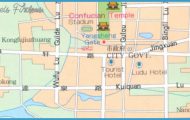Public Transport (local) China has a good local public transport network. Bicycles are one of China’s main means of transport (see entry). See entry See entry See Taxis Buses and trams run for short distances over the main routes in the cities (see also Buses). They are usually overcrowded, very slow and to be avoided at all costs during the rush hour. Fares are based on distance.
Beijing and Shanghai have their own underground railway systems, and another metro is under construction in Canton. These subway trains are faster and much less crowded than the other forms of local transport and signs at the stations are written in Pinyin as well as Chinese; the name of
Radio Beijing Domestic Scene is a programme for foreigners in Beijing which broadcasts news, sport and weather, as well as reporting on various aspects of China. It goes out in English on 1251 kHz medium wave from 1 to 3pm and 11pm to midnight and between 4 and 6am, and on FM on 91.55 MHz (for further information call 801 31 35 in Beijing).
China’s state-run television CCTV (China Central Television) transmits a number of news and weather reports in English, and some ofthe big hotels have satellite TV which can pick up English-language broadcasts such as those by CNN.
A journey by train is one of those unique experiences that no visitor to China should miss. The slow pace will give you as a foreigner a real chance to absorb the scenery and to get to know the people. There are special trains for tourists between the main cities open to tourism, and overseas groups can ask for additional carriages to be attached.
China’s rail network covers every part ofthe country except Tibet. The first line to be electrified was the western section of the Baocheng line which connects Shaanxi Province with south-western China and crosses the Longhai line running through the province.














